The text of the book ""
Current page: 3 (the book has 11 pages in total) [available passage for reading: 8 pages]
§ 9. The structure of the stem
1. What is called an escape?
2. What functions are performed by mechanical, conductive, integumentary tissue?
3. What stems do you know plants have?
4. What is the difference between the stems of trees, shrubs, grasses?
Stem- the axial part of the plant shoot. It conducts nutrients and brings leaves to the light. The stem can store spare nutrients. Leaves, flowers, fruits with seeds develop on it.
Variety of stems. There are two main types of stems: herbaceous and woody.
Herbaceous stems usually exist for one season. These are delicate flexible stems of grasses and young shoots of trees. Woody stems acquire hardness due to the deposition of a special substance in the membrane of their cells - lignin. Lignification occurs in the stems of trees and shrubs starting from the second half of the summer of the first year of their life.
Rice. 35. Variety of stems
Herbaceous plants are better adapted to changing environmental conditions, their forms are very diverse. They grow in water and in very arid places, in hot tropics and in permafrost regions.
In the direction of growth, the stems are divided into erect, curly, climbing, creeping (Fig. 35).
Most plants erect stems, they grow vertically upward. Erect stems have well-developed mechanical tissue. They can be lignified (birch, apple) or herbaceous (sunflower, corn).
Curly stems, rising up, twine around the support (field bindweed, beans, hops).
Climbing stems rise up, clinging to the support with antennae (grapes, peas) or adventitious roots growing from the stem (ivy).
Creeping stems spread along the ground and can take root in nodes (strawberries, cinquefoil).
Internal structure of the stem. On a cross-section of a branch or cut of a tree, it is easy to distinguish the following areas: bark, cambium, wood and core (Fig. 36).
Young (annual) stems are covered outside skin, which is then replaced stopper, consisting of dead cells filled with air (Fig. 37). The skin and cork are integumentary tissues. They protect the stem cells located deeper from excessive evaporation, various damages, from the penetration of atmospheric dust with microorganisms that cause plant diseases.
In the skin of the stem, as in the skin of the leaf, there are stomata through which gas exchange takes place. Developing in traffic lentils- small tubercles with holes, bury visible from the outside, especially in elder, oak and bird cherry (see Fig. 37). Lentils are formed by large cells of the main tissue with large intercellular spaces. Gas exchange is carried out through them.
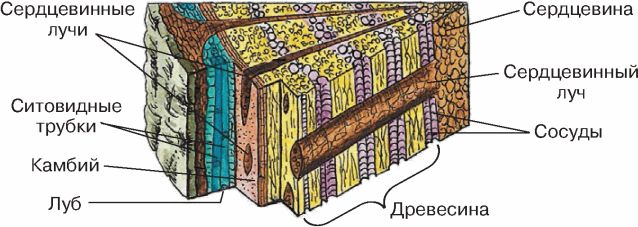
Rice. 36. Layers on the trunk of a sawn tree
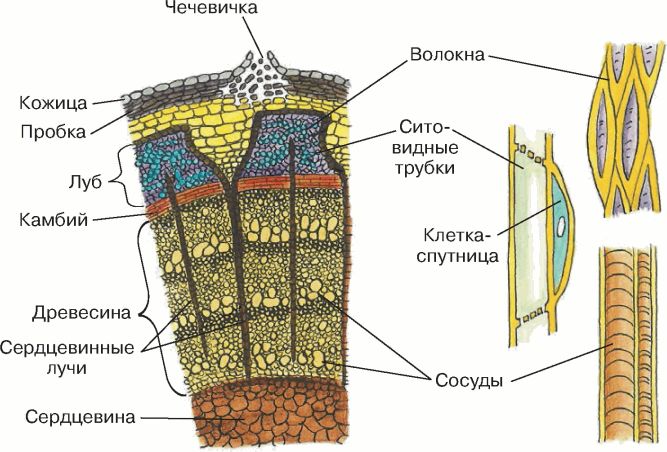
Rice. 37. Cross section of a branch under a microscope
Some trees develop thick cork layers. A very strong cork develops on the trunk of a cork oak. It is used for various household needs.
Under the skin and cork are bark cells that may contain chlorophyll - this is the main tissue. The inner layer of the bark is called bast. It consists of sieve tubes and companion cells, thick-walled bast fibers, as well as groups of cells of the main tissue.
Sieve tubes- this is a vertical row of elongated living cells, in which the transverse walls are pierced with holes (like a sieve), the nuclei in these cells have collapsed, and the cytoplasm is adjacent to the membrane. This is a conductive bast tissue, along which solutions of organic substances move. The vital functions of the sieve tubes are provided by companion cells.
Bast fibers- elongated cells with destroyed contents and lignified walls - represent the mechanical tissue of the stem. In the stems of flax, linden and some other plants, bast fibers are especially well developed and very strong. Linen is made from the bast fibers of flax, and bast and matting are made from the bast fibers of linden.
The densest, widest, deeper layer is wood- the main part of the stem. It is formed by cells of various shapes and sizes: vessels of conducting tissue, wood fibers of mechanical tissue and cells of the main tissue.
All layers of wood cells formed in spring, summer and autumn make up annual ring gain. Small autumn cells differ from large spring wood cells of the next year, which are next to them. Therefore, the border between adjacent growth rings on the cross section of wood is clearly visible in many trees. By counting the number of tree rings with a magnifying glass, you can determine the age of a cut tree or branch cut.
By the thickness of the growth rings, you can find out in what conditions the tree grew in different years of life. Narrow annual rings indicate a lack of moisture, tree shading and poor nutrition (Fig. 38).
Between bark and wood lies cambium. It consists of narrow, long cells of educational tissue with thin membranes. It cannot be detected with the naked eye, but you can feel it by peeling off part of the bark from the surface of the wood and running your fingers over the exposed area. At the same time, the cambium cells rupture, and their contents flow out, moistening the wood.

Rice. 38. The influence of living conditions on the growth of a tree in thickness
In spring and summer, the cambium vigorously divides, and as a result, new bast cells are deposited towards the bark, and new wood cells towards the wood. This is how the stem grows in thickness. When the cambium is divided, the number of wood cells is much larger than the bast. In autumn, cell division slows down, and in winter it stops completely.
There is a looser layer in the center of the stem - core, in which stores of nutrients are deposited. It is clearly visible, for example, in aspen, elderberry and some other plants. Birch and oak have a very dense core, and it is difficult to see the border with wood. It consists of large cells of the main tissue with thin membranes. Some plants have large intercellular spaces between cells. This core is very loose.
From the core in the radial direction through the wood and bast pass core rays. They consist of cells of the underlying tissue and perform storage and conduction functions.
Internal structure of a tree branch
1. Examine the branch, find lentils (tubercles with holes) on it. What role do they play in the life of the tree?
2. Prepare the cross and longitudinal cuts of the branch. Use a magnifying glass to examine the layers of the stem in the slices. Using the tutorial, identify the name of each layer.
3. Separate the bark with a needle, try to bend it, break it, stretch it. Read in the textbook what the outer layer of the bark is called. What is bast? Where is it located and what is its significance for the plant?
4. On a longitudinal cut, examine the bark, wood, core. Test each layer for strength.
5. Separate the bark from the wood, slide your finger over the wood. How do you feel? Read the tutorial about this layer and its meaning.
6. Sketch the cross section and longitudinal section of the branch, and label each part of the stem.
7. Find wood on the cut of a tree stem, use a magnifying glass to count the number of tree rings and determine the age of the tree.
8. Consider the growth rings. Are they the same thickness? Explain the difference between wood formed in spring and wood from later seasons.
9. Establish which layers of wood are older in age - lying closer to the middle or to the bark. Explain why you think so.
The structure of the stem of herbaceous plants differs from the structure of the stem of woody species. In herbaceous plants, cells are not lignified, and mechanical tissues are poorly developed. The cells of the main tissue are well developed in the stems of grasses.
In the stems of dicotyledonous plants there is educational tissue of cambium, and the stems of monocotyledonous plants do not have cambium, so they almost do not grow in thickness (Fig. 39).
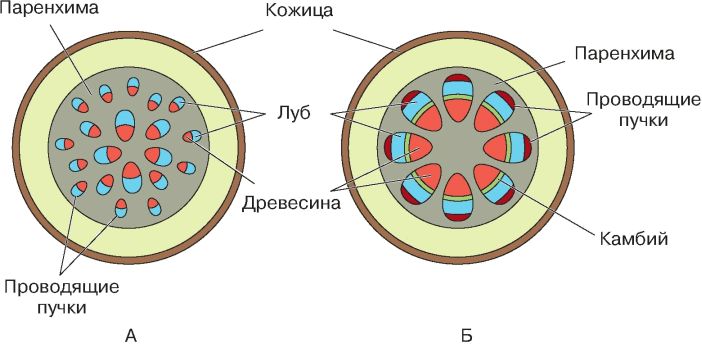
Rice. 39. The structure of the stems of monocotyledonous (A) and dicotyledonous (B) plants
HERBAL AND WOODY STALKS. Erect, curly, climbing and creeping stems. LENTURIES. CORK. BARK. LUB. Sieve tubes. BREAST FIBERS. CAMBIUM. WOOD. CORE. HEART RAYS
Questions
1. What is the internal structure of the stem of a tree or shrub?
2. What is the significance of the peel and cork?
3. Where is the bast located and what cells does it consist of?
4. What is cambium? Where it is located?
5. What layers are visible on a cross-section of the stem when viewed with the naked eye and with a microscope?
6. What are tree rings? How are they formed?
Think
What can be determined by the growth rings? Why are tree rings not visible in many tropical plants?
Tasks
1. Consider lentils on the branches of elderberry, bird cherry, oak and other trees and shrubs.
2. Determine the age of any tree cut from the tree rings. Draw a saw cut. Indicate in the picture the side that the tree was facing north.
3. Take branches of apple, wild rosemary (Siberian rhododendron), cherry and put them in a vessel with water in a warm, bright room. Add fresh water to the vessel. After one and a half to two weeks, flowers will bloom on the branches. Use them when studying the structure of a flower.
Do you know that…
In most trees, smooth cork is replaced by a fractured crust. It consists of alternating layers of cork and other dead bark tissue.
In fruit trees, the crust is usually formed at the 6-8th year of life, in the linden - at the 10th-12th, in the oak - at the 25th-30th. Some trees (sycamore, eucalyptus) do not form a crust at all.
Dwarf juniper trees in the tundra have a trunk only 8 cm thick, American sequoias reach 10 m in diameter at the base of the trunk, and our oaks are over 1 m.
From the tree rings, it was possible to establish that the baobab and dracaena can be considered the most durable trees. In Africa, specimens of these trees were found, the age of which is about 6 thousand years.
In our country, the most durable are cypresses (3 thousand years), oaks, chestnuts, cedars (2 thousand years), spruce (1.6 thousand years), linden (1 thousand years).
§ 10. Modifications of shoots
1. What root modifications do you know? What functions do they perform?
2. What leaf modifications do you know? What is their function?
3. What are the main functions of the stem?
4. What is called an escape?
Along with typical shoots, plants often develop modified shoots that perform other functions.
Some perennial herbaceous plants have a peculiar underground storeroom. The aboveground parts of these plants die off annually by autumn. Roots and modified underground shoots - rhizomes, tubers and bulbs - remain in the soil. It is in them that the reserves of organic matter are deposited for the winter.
Rhizome is found in many plants, for example, nettle, wheatgrass, iris, lily of the valley, aspidistra indoor plant (Fig. 40). Outwardly, the rhizome resembles a root, but, like a terrestrial shoot, it has apical and axillary buds, as well as membranous scales - modified leaves. Adventitious roots grow from the rhizome, and young aerial shoots develop from the apical or axillary bud in spring. They use the nutrients deposited in the rhizome in the fall. If a piece of rhizome with a bud and adventitious roots is planted in the soil, a new, independently existing plant will develop. Some perennial ornamental plants reproduce by dividing the rhizomes into parts.
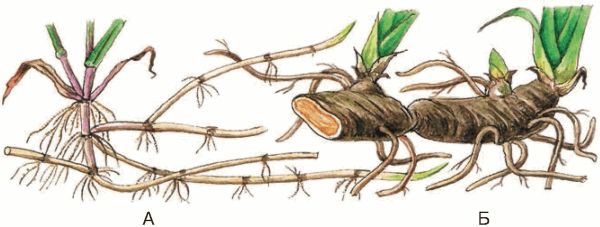
Rice. 40. Rhizomes of wheatgrass (A) and iris (B)
Tubers are found, for example, in potatoes, corydalis, Jerusalem artichoke fodder plant (earthen pear). The underground shoots on which they develop grow from the bases of the above-ground stems. These shoots are called stolons. Tubers are the apical thickening of the stolons.
On the surface of the tuber in the depressions there are 2-3 buds, called eyes. There are more eyes on the side of the tuber, which is called top. Opposite side - basis- the tuber is connected to the stolon (Fig. 41).
Study the tuber structure in more detail on your own.
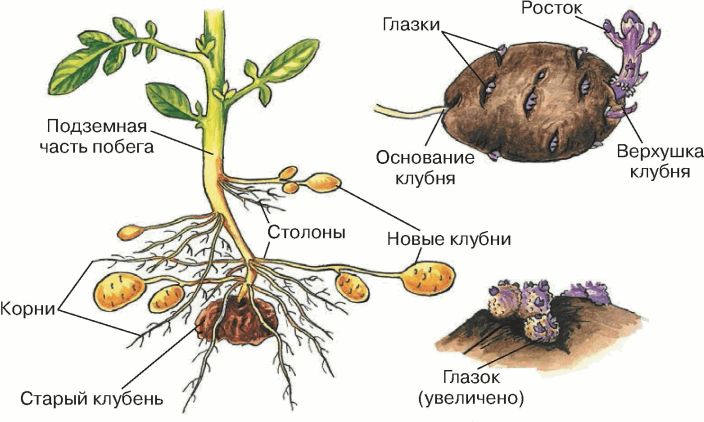
Rice. 41. Tuber formation in potatoes
Tuber structure
1. Consider a potato tuber. Find the base and top.
2. Consider the eyes. What is their location on the tuber? Use a magnifying glass to examine the buds in the peephole.
3. Make a thin cross-section of the tuber. Consider it to the light. Compare the cross-section of the tuber with the cross-section of the stem (fig. 42).
4. Sketch the cross section of the tuber.
5. Put iodine on the cut of the tuber. Explain what happened.
6. Prove that the tuber is a modified underground shoot.

Rice. 42. Tuber - a modified shoot
Organic matter constantly flows from the leaves of the potato through the stems into the stolons and is deposited in the tops in the form of starch. The tops of the stolons grow, thicken, and by autumn they turn into large tubers.
Bulbs form perennial plants - onions, lilies, tulips, daffodils, wild goose onions.
In the lower part of the onion bulb, there is an almost flat stem - the bottom. On the bottom there are modified leaves - scales. The outer scales are dry and leathery, while the inner ones are fleshy and juicy. They contain water reserves with sugar and other substances dissolved in it. The presence on the bottom of the buds located in the axils of the scales (Fig. 43) confirms that the bulb is a modified shoot.
Study the structure of the bulb yourself by doing laboratory work.
Bulb structure
1. Consider the external structure of the bulb. What is the significance of dry scales?
2. Slice the onion lengthwise. Draw a longitudinal section of the bulb, mark the scales, bottom, buds, adventitious roots.
3. Prove that the bulb is a modified underground shoot.
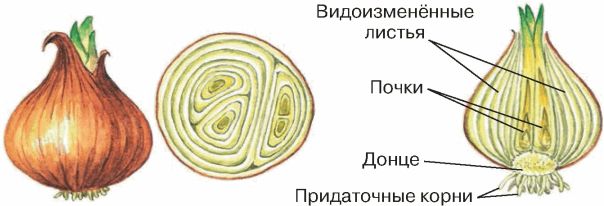
Rice. 43. Onion bulb
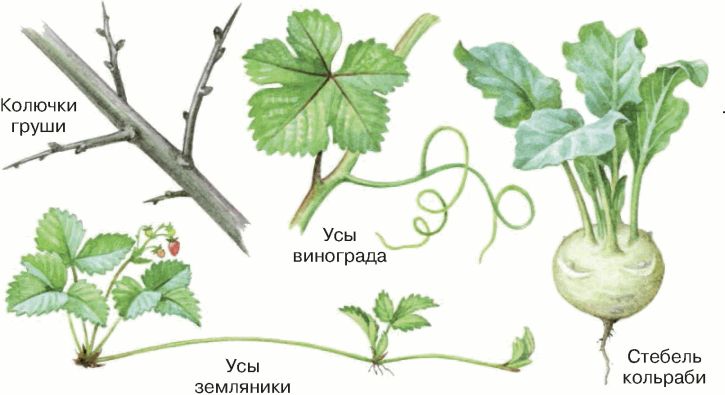
Rice. 44. Modified shoots
If the bulb is planted in the ground, a fibrous root system is formed on the underside of the bottom. Sometimes young bulbs, called babies, develop from the buds. Each baby bulb can grow an independent plant.
Aboveground modifications of the shoot are thorns of wild apple, pear, hawthorn, which protect plants from being eaten by animals. Antennae of grapes, cucumbers, pumpkins, melons, strawberry whiskers are also modified shoots. Another example of a modified above-ground shoot is the thickening of internodes of the kohlrabi cabbage stem (Fig. 44).
MODIFIED Escape. RHIZOME. TUBER. BULB
Questions
1. What modified underground shoots do you know? Name the plants that have a rhizome, tuber, bulb.
2. How does a potato tuber develop?
4. What is the structure of the bulb?
5. How to prove that the rhizome and bulb are modified shoots?
6. What aerial modifications of the shoot do you know?
Think
By what signs can you distinguish tubers from a root crop, a rhizome from a root?
Tasks
1. Place the onion bulb in a narrow-necked jar so that it does not fall through, but only touches the bottom of the water poured into the jar. Observe the development of adventitious roots and green leaves on the bulb. Why does it grow even though it is not in the soil?
2. With the onset of warm spring weather, watch the flowering of bulbous and rhizome plants. Identify the names of these plants. Mark the beginning and end of flowering, and also indicate what is typical for these plants in a given period of the year.
Do you know that…
Gladiolus has a special modified shoot - the corm. Outwardly, it looks like an onion, but all its leaf scales are dry, and spare products are deposited in the stem part.
§ 11. Flower
1. What is the structure of a flower (generative) bud?
2. What is called an escape?
Flower- a modified shortened shoot, used for seed reproduction. The main or lateral shoot usually ends in a flower. Like any shoot, a flower develops from a bud. The stem part of the flower is represented by the peduncle and receptacle, and the calyx, corolla, stamens and pistils are formed by modified leaves.
No matter how great the variety of flowers of the plants around us, similarities can be found in their structure. Consider, for example, an apple blossom.
Apple flower structure(fig. 45). In the center of the flower is clearly visible pestle. He is surrounded by numerous stamens. The pistil and stamens are the main parts of the flower. Around the stamens and pistil is located perianth. In the apple tree, the perianth consists of two types of leaflets. Inner leaves are petals, constituents whisk. Outer leaves - sepals- form a cup.
The corolla of an apple tree flower consists of white or white-pink non-accrete petals. In other plants (fragrant tobacco, ashberry, black nightshade, primrose), the petals grow together in the lower part into a tube. Therefore, a distinction is made between free-petaled and spine-lobed corollas.
The calyx of the apple tree flower consists of five green leaves accreted at the base. In some plants, for example, the carnation, the sepals grow together in the lower parts into a tube. In others, such as geraniums, the sepals do not grow together.
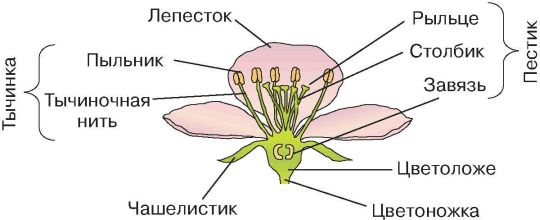
Rice. 45. The structure of the apple blossom

Rice. 46. The structure of a flower with a double (A) and simple (B) perianth
The thin stalk on which most plants have a flower is called pedicel, and its upper, expanded part, which can take on various shapes, - a receptacle.
Perianth double and simple(fig. 46). In the apple tree, the perianth consists of a calyx and a corolla. Such a perianth is called double. In addition to the apple tree, cherries, cabbage, roses and many other plants have it.
In some plants, mainly in monocots (lily, amaryllis, tulip), all tepals are more or less the same. Such a perianth is called simple. In some plants, the leaves of a simple perianth are large and bright, for example, in a tulip or an orchid, while in others, for example, in a rush, they are inconspicuous.
The flowers of willow and ash have no perianth at all. They are called naked.
The flowers are right and wrong. Tepals (single and double) can be arranged so that several planes of symmetry can be drawn through it (apple, cherry, cabbage, etc.). Such flowers are called correct. Flowers through which only one plane of symmetry (peas, sage) can be drawn are called wrong.
The structure of the stamen and pistil(fig. 47). In an apple tree, each stamen has anther, inside which pollen ripens.
Rice. 47. The structure of the stamen and pistil
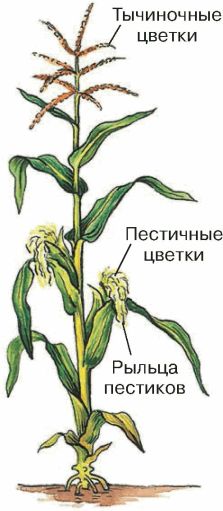
Rice. 48. Corn is a monoecious plant
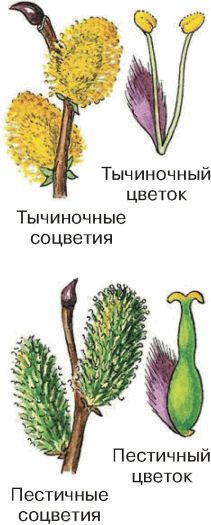
Rice. 49. Willow is a dioecious plant
The boot is located on filament. The pistil has stigma, columns and ovary. In an apple tree, the pistil is formed by five columns fused together at the base. In the upper part, they are free, and each carries one stigma. The ovary is five-celled. The nests contain ovules, from which seeds develop after flowering.
Flowers are bisexual and dioecious. Most plants have flowers that contain both stamens and pistils. These are bisexual flowers. But in some plants (cucumber, corn), some flowers have only pistils - pistillate flowers, while others are just stamens - staminate flowers. Such flowers are called dioecious.
Flower formula. When drawing up a flower formula, a simple perianth is indicated by the letter O, sepals - by the letter H, petals - L, stamens - T, pistil - P. The number of sepals, petals, stamens, pistils is shown in numbers, and if there are more than twelve, then by ∞. If any parts of the flower have grown together, then the corresponding numbers are written in brackets.
The correct flower is depicted with an asterisk *, the wrong one - with an arrow, unisexual male (staminate) flowers - with a sign, female (pistillate) -. For example, the formula of a cucumber staminate flower * H (5) L (5) T (2) + (2) +1 P 0; formula of a pistillate flower of a cucumber * H (5) L (5) T 0 P (3).
Plants are monoecious and dioecious. Plants such as cucumbers and corn are called monoecious(Fig. 48), as their pistillate and staminate flowers develop on the same plant. Hemp, poplar and willow are called dioecious plants (Fig. 49), since they have staminate flowers on some plants, and pistillate flowers on others. Some sedge species are also dioecious.
Flower structure
1. Consider a flower. Find the peduncle, receptacle, perianth, stamens, and pistil.
2. Dismember the flower, count the number of sepals, petals, stamens, pistils.
3. Determine which perianth of the given flower - simple or double.
4. Determine which calyx is separate-leaved or spiny-leaved, which corolla is free-lobed or spliced.
5. Consider the structure of the stamen. Find the anther and filament. Examine the dust cover under a magnifying glass. It contains many tiny pollen grains.
6. Examine the pistil. Find a stigma, a column, an ovary. Cut the ovary across, examine under a magnifying glass. Find the ovule. What is formed from the ovule? Why are the stamens and the pistil called the main parts of the flower?
7. Draw parts of the flower and sign their names.
8. Formulate the studied flower.
PESTLE. STAMEN. PETALS. Wreath. CUPLES. CUP. PEDUNCLE. RECEPTACLE. SIMPLE AND DOUBLE COLORFUL. STAMINA THREAD. ANTHER. STIGMA. COLUMN. OVARY. SEED. SINGLE AND DOUBLE HOUSING PLANTS
Questions
1. What parts does the flower consist of?
2. What is called the perianth?
3. How is the double perianth different from the simple one?
4. What is the structure of the pistil and stamen?
5. What develops from the ovule?
6. How are monoecious plants different from dioecious plants?
Think
On what basis can one say that a flower is a modified shoot?
Tasks
Consider the structure of primrose and amaryllis flowers. Compare their structure with the structure of apple blossoms. Name each part of the flower.
Do you know that…
The giant flower of rafflesia (Fig. 50), growing in the forests of tropical Asia, reaches almost 1 m in diameter. Its seeds germinate on the roots of the host plant. Rafflesia has no stem or leaves. It receives nutrients from the plant on which it grows.
Rafflesia flowers both in appearance and smell resemble decaying pieces of meat, which attracts flies that carry its pollen. The seeds of this plant are spread by animals, including elephants, to whose limbs they stick.
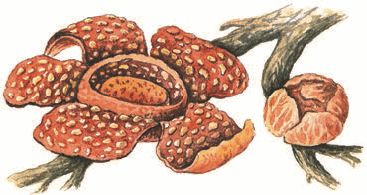
Rice. 50. Rafflesia Flower







